ZTE Z828 GSM/WCDMA/LTE Mobile Phone User Manual ZTE T22
ZTE Corporation GSM/WCDMA/LTE Mobile Phone ZTE T22
ZTE >
User manual
1
Z828
User Manual

2
About This Manual
Copyright
Copyright © 2015 ZTE CORPORATION
All rights reserved.
Approved Firmware Versions: No part of this publication may
be quoted, reproduced, translated or used in any form or by any
means, electronic or mechanical, including photocopying and
microfilm, without the prior written permission of ZTE
Corporation.
ZTE Corporation reserves the right to correct typographic errors,
misprints or update specification in this guide without prior notice.
The Bluetooth® trademark and logos are owned by the Bluetooth
SIG, Inc. and any use of such trademarks by ZTE Corporation is
under license.
Other trademarks and trade names are the property of their
respective owners.
Manufactured under license from Dolby Laboratories. Dolby and
the double-D symbol are trademarks of Dolby Laboratories.
We offer self-service for our smart terminal device users. Please
visit the ZTE official website (at www.ztedevice.com) for more
information on self-service and supported product models.
Information on the website takes precedence.
3
Version No.: R1.0
Edition Time: March 20, 2015

4
Contents
Getting Started ......................................................... 9
Getting to Know Your Phone .............................................. 9
Knowing the Keys ............................................................ 11
Installing the nano-SIM Card and the Battery ................... 11
Installing the microSDHC™ Card ..................................... 13
Charging the Battery ........................................................ 14
Extending the Battery Life ................................................ 16
Powering On/Off .............................................................. 16
Setting Up for the First Time ............................................ 17
Locking/Unlocking the Screen and Keys .......................... 17
Using the Touch Screen ................................................... 18
Getting to Know the Home Screen ................................... 19
Personalizing.......................................................... 20
Changing the System Language ...................................... 20
Setting the Date and Time................................................ 20
Changing Ringtone and Notification Sound ...................... 20
Turning On/Off Touch Sound ............................................ 21
Adjusting Volume ............................................................. 21
Applying New Wallpapers ................................................ 21
Changing Screen Brightness ........................................... 22
Protecting Your Phone With Screen Locks ....................... 22
Protecting Your Phone With Encryption ............................ 23
5
Knowing the Basics ............................................... 25
Monitoring the Phone Status ............................................ 25
Managing Notifications ..................................................... 26
Managing Shortcuts and Widgets ..................................... 28
Organizing With Folders ................................................... 29
Rearranging the Primary Icons ......................................... 30
Entering Text .................................................................... 31
Editing Text ...................................................................... 33
Opening and Switching Apps ............................................ 34
Connecting to Networks and Devices .................. 35
Connecting to Mobile Networks ........................................ 35
Connecting to Wi-Fi® ........................................................ 37
Using Wi-Fi Direct® .......................................................... 40
Connecting to Bluetooth® Devices .................................... 41
Connecting to Your Computer via USB ............................. 43
Sharing Your Mobile Data Connection .............................. 45
Connecting to Virtual Private Networks ............................. 48
Phone Calls ............................................................ 50
Placing and Ending Calls ................................................. 50
Answering or Rejecting Calls ............................................ 51
Working With the Call Log ................................................ 52
Calling Your Contacts ....................................................... 53
Checking Voicemail .......................................................... 53
Using Options During a Call ............................................. 54
Managing Multi-party Calls ............................................... 55
6
Adjusting Your Call Settings ............................................. 56
Contacts .................................................................. 62
Checking Contact Details ................................................. 62
Adding a New Contact ..................................................... 62
Setting Up Your Own Profile ............................................. 63
Importing, Exporting, and Sharing Contacts ..................... 63
Working With Favorite Contacts ....................................... 65
Working With Groups ....................................................... 65
Searching for a Contact ................................................... 67
Editing Contacts............................................................... 68
Accounts ................................................................. 71
Adding or Removing Accounts ......................................... 71
Configuring Account Sync ................................................ 72
Email ....................................................................... 74
Setting Up the First Email Account ................................... 74
Checking Your Emails ...................................................... 74
Responding to an Email ................................................... 75
Writing and Sending an Email .......................................... 76
Adding and Editing Email Accounts .................................. 77
Changing General Email Settings .................................... 77
Messaging .............................................................. 79
Opening the Messaging Screen ....................................... 79
Sending a Message ......................................................... 79
Replying to a Message .................................................... 80
Forwarding a Message .................................................... 81
7
Changing Messaging Settings .......................................... 81
Calendar ................................................................. 82
Viewing Your Calendars and Events ................................. 82
Creating an Event ............................................................ 83
Editing, Deleting or Sharing an Event ............................... 84
Changing Calendar Settings ............................................. 84
Snapdragon Camera .............................................. 85
Capturing a Photo ............................................................ 85
Recording a Video ............................................................ 87
Customizing Camera/Camcorder Settings ........................ 87
More Apps .............................................................. 90
Clock ............................................................................... 90
Backup and Restore ......................................................... 91
Calculator ........................................................................ 91
Downloads ....................................................................... 91
File Manager .................................................................... 92
News and Weather ........................................................... 92
Sound Recorder ............................................................... 93
Task Manager .................................................................. 93
Google Apps .................................................................... 94
Settings .................................................................. 96
Wireless and Networks ..................................................... 96
Device ............................................................................. 98
Personal ........................................................................ 101
System........................................................................... 106
8
Upgrading the Phone Software ........................... 107
Troubleshooting ................................................... 108
For Your Safety .................................................... 112
General Safety............................................................... 112
FCC RF Exposure Information (SAR) ............................. 113
FCC Regulations ........................................................... 115
Hearing Aid Compatibility (HAC) regulations for Mobile
Phones .......................................................................... 116
CTIA Requirements ....................................................... 118
Radio Frequency Interference ........................................ 119
Explosive Environments ................................................. 121
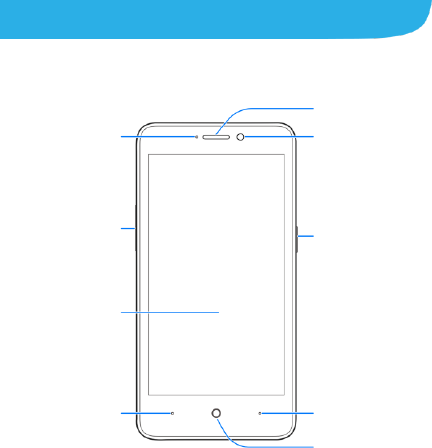
9
Getting Started
Getting to Know Your Phone
Indicator light
Volume key
Touch screen
Back key
Earpiece
Front camera
Power key
Recent apps key
Home key
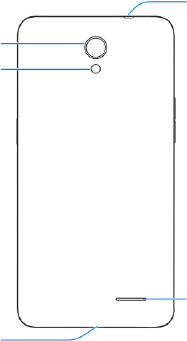
10
Back camera
Flash
Charging/
micro-USB jack
Speaker
Headset jack

11
Knowing the Keys
Key
Function
Power key
Press and hold to turn on or off airplane mode,
restart, or to power off.
Press to turn off or on the screen display.
Home key
Touch to return to the home screen from any
application or screen.
Touch and hold to use Google search.
Recent apps key
Touch to see recently used apps.
Back key
Touch to go to the previous screen.
Volume key
Press or hold either end to turn the volume up or down.
Installing the nano-SIM Card and the
Battery
Switch off your phone before installing or replacing the battery or
the nano-SIM card.
1. Insert your fingernail into the slot at the bottom left of the back
cover and lift it up gently.
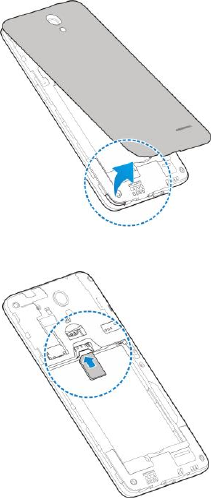
12
2. Hold the nano-SIM card with the cut corner oriented as shown
and slip them into the card holder.
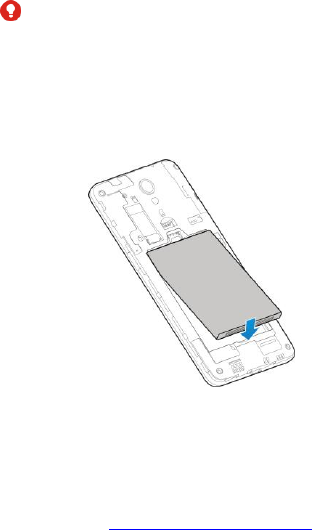
13
WARNING!
To avoid damage to the phone, do not use any other kind of
SIM card, or any non-standard nano-SIM card cut from a SIM
card. You can get a standard nano-SIM card from your
service provider.
3. Insert the battery by aligning the metal contacts on the battery
with the metal contacts in the battery compartment. Gently
push down on the battery until it clicks into place.
4. Align the back cover with the back of the phone and press the
cover back into place. Ensure that all the tabs are secure and
there are no gaps around the cover.
Installing the microSDHC™ Card
The microSDHC card can be installed and removed while the
phone is turned on. Unmount the microSDHC card before
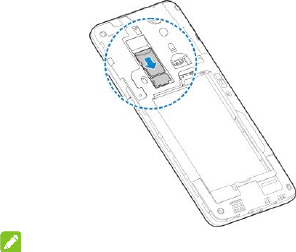
14
removing it.
1. Remove the back cover.
2. Hold your microSDHC card with the metal contacts facing
down and slide it in.
NOTE:
Some applications may require a microSDHC card to store
certain data on it and to work properly. Therefore, it is
recommended that you keep a microSDHC card installed and
not remove or replace it unnecessarily.
3. Replace the back cover.
Charging the Battery
Your phone’s battery should have enough power for the phone to
turn on, find a signal, and make a few calls. You should fully
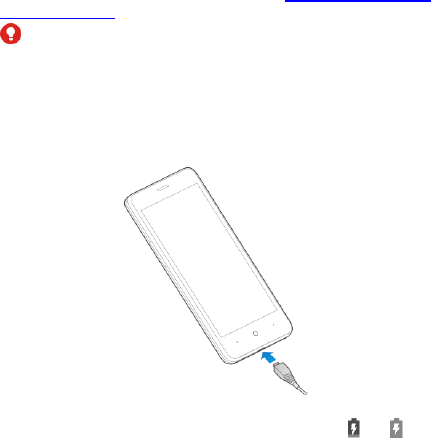
15
charge the battery as soon as possible.
If the battery is low, there will be a pop-up message on the
screen. As you charge your phone, the screen will tell you the
exact battery level on the lock screen. See Locking/Unlocking the
Screen and Keys.
WARNING!
Use only ZTE-approved chargers and cables. The use of
unapproved accessories could damage your phone or cause the
battery to explode.
1. Connect the adapter to the charging jack. Ensure that the
adapter is inserted with the correct orientation. Do not force
the connector into the charging jack.
2. Connect the charger to a standard AC power outlet. If the
phone is on, you’ll see a charging icon, such as or ,
appear on the status bar.

16
3. Disconnect the charger when the battery is fully charged.
NOTE:
If the battery is extremely low, you may be unable to power on
the phone even when it is being charged. In this case, try again
after charging the phone for at least 20 minutes. Contact
customer service if you still cannot power on the phone after
prolonged charging.
Extending the Battery Life
Active applications, screen brightness levels, Bluetooth and Wi-Fi
usage and GPS functionality can drain your battery. You can
follow the helpful tips below to conserve your battery power:
Reduce the screen backlight time.
Lower the screen brightness.
Turn auto-sync, Wi-Fi, and Bluetooth off when not in use.
Disable the GPS function when not in use. Most applications
using this function will periodically query the GPS satellites
for your current location; each query drains your battery.
Powering On/Off
Press and hold the Power key to turn on your phone.
To power off, press and hold the Power key to open the
options menu. Touch Power off > OK.
NOTE:
If the phone freezes or takes too long to respond, you can press

17
and hold the Power key for about 10 seconds to power the
phone off, and then turn it on again.
Setting Up for the First Time
When you first power on your phone after you purchase it or
reset it to factory settings (see Backup and Reset), you need to
do some settings before using it.
Touch the language field to select the language you want to use
and then touch Start. Then follow the prompts to set up Wi-Fi,
owner name, Google services and other options.
Locking/Unlocking the Screen and
Keys
Your phone allows you to quickly lock the screen and keys (put
the phone into sleep mode) when not in use and to turn the
screen back on and unlock it when you need it.
To lock the screen and keys:
To quickly turn the screen off and lock the keys, press the Power
key.
NOTE:
To save battery power, the phone automatically turns off the
screen after some time of inactivity. You will still be able to
receive messages and calls while the phone screen is off.
To unlock the screen and keys:
1. Press the Power key to turn the screen on.

18
2. Touch and hold the3 scrren.
- or -
Touch the Camera icon at the bottom right and swipe left to
open the Camera app.
NOTE:
If you have set an unlock pattern, PIN or password for your
phone (see Protecting Your Phone With Screen Locks), you’ll
need to draw the pattern or enter the PIN/password to unlock
your screen.
Using the Touch Screen
Your phone’s touch screen lets you control actions through a
variety of touch gestures.
Touch
When you want to type using the onscreen keyboard, select
onscreen items such as application and settings icons, or
press onscreen buttons, simply touch them with your finger.
Touch and Hold
To open the available options for an item (for example, a
message or link in a web page), touch and hold the item.
Swipe or Slide
To swipe or slide means to quickly drag your finger vertically
or horizontally across the screen.
Drag
To drag, press and hold your finger with some pressure
before you start to move your finger. While dragging, do not

19
release your finger until you have reached the target position.
Pinch
In some apps (such as Maps, Browser, and Gallery), you can
zoom in and out by placing two fingers on the screen at once
and pinching them together (to zoom out) or spreading them
apart (to zoom in).
Rotate the screen
For most screens, you can automatically change the screen
orientation from portrait to landscape by turning the phone
sideways.
Getting to Know the Home Screen
The home screen is the starting point for your phone’s
applications, functions, and menus. You can customize your
home screen by adding shortcuts, folders, widgets, and more.
Extended Home Screens
Your home screen is extendable, providing more space for
shortcuts, folders, widgets, and more. Simply swipe left or right
on the screen to see the extended panels.
See Managing Home Screen Icons and Widgets for more
information on how to add or remove additional home screen
panels.

20
Personalizing
Changing the System Language
1. Touch the Home key > > Settings > Language &
input > Language.
2. Select the language you need.
Setting the Date and Time
1. Touch the Home key > > Settings > Date & time.
2. Touch Automatic date & time and Automatic time zone if
you want to set the date, time and time zone by yourself.
3. Set the date, time, time zone, and date/time format.
Changing Ringtone and Notification
Sound
You can customize the default incoming call ringtone for each
micro-SIM card the default notification sound.
1. Touch the Home key > > Settings > Sound &
notification.
2. Touch Default notification ringtone or Phone ringtone.
3. Scroll through the ringtone list and select the ringtone you
want to use.
4. Touch OK.

21
NOTE:
See Set a Ringtone for a Contact for how to assign a special
ringtone to an individual contact.
Turning On/Off Touch Sound
1. Touch the Home key > > Settings > Sound &
notification > Other sounds.
2. Touch Touch sounds.
Adjusting Volume
1. Touch the Home key > > Settings > Sound &
notification.
2. Drag the sliders below Media volume, Alarm volume and
Ring volume to adjust the volume for each type of audio.
NOTE:
You can adjust the media volume when a media application is in
use by pressing the Volume key. If no media application is active,
press the Volume key to adjust ringtone volume (or the earpiece
volume during a call).
Applying New Wallpapers
You can set the wallpaper for the home screen.
1. Touch the Home key.
2. Touch and hold an empty area of the home screen.

22
3. Touch WALLPAPERS to pick an image as the wallpaper.
Changing Screen Brightness
1. Touch the Home key > > Settings > Display >
Brightness level.
2. Drag the slider to manually adjust the screen brightness.
NOTE:
With the proximity and light sensor, your phone can automatically
adjust the screen brightness for available light. Touch Adaptive
brightness in the Display settings screen to turn the feature on
or off.
Protecting Your Phone With Screen
Locks
You can protect your phone by creating a screen lock. When it is
enabled, you need to swipe the screen, look at the front camera,
draw a pattern or enter a numeric PIN or a password to unlock
the phone’s screen and keys.
1. Touch the Home key > > Settings > Security > Screen
lock.
2. Touch None, Long press, Pattern, PIN or Password.
Touch None to disable the screen lock.
Touch Long press to enable screen lock and allow
unlocking with a ‘touch and hold’ gesture.

23
Touch Pattern to draw and redraw your a pattern that you
must draw to unlock the screen.
Touch PIN or Password to set a numeric PIN or a
password that you must enter to unlock the screen.
3. For Pattern, PIN, or Password lock, select how you want
notifications and their contents to show when the phone is
locked. Then touch DONE.
Protecting Your Phone With Encryption
You can encrypt all the data on your phone: your accounts,
application data, music and other media, downloaded information,
and so on. If you do, you must draw a pattern or enter a numeric
PIN or a password each time you power on your phone.
WARNING!
Encryption is irreversible. The only way to revert to an
unencrypted phone is to perform a factory data reset which
erases all your data.
Encryption provides additional protection in case your phone is
stolen and may be required or recommended in some
organizations. Consult your system administrator before turning it
on. In many cases the PIN or password you set for encryption is
controlled by the system administrator.
Before turning on encryption, prepare as follows:
Set a lock screen pattern, PIN, or password.
Charge the battery.
Keep the phone connected to the charger.

24
Schedule an hour or more for the encryption process. You
must not interrupt it or you will lose some or all of your data.
When you're ready to turn on encryption:
1. Touch the Home key > > Settings > Security > Encrypt
phone.
2. Touch ENCRYPT PHONE.
The ENCRYPT PHONE button is dimmed if your battery is
not charged or your phone is not plugged in.
If you change your mind about encrypting your phone, touch
the Back Key.
WARNING!
If you interrupt the encryption process, you will lose data.
Read the information about encryption carefully.
3. Draw the lock screen pattern, or enter your lock screen PIN or
password and touch NEXT.
4. Touch ENCRYPT PHONE.
The encryption process starts and displays its progress.
Encryption can take an hour or more, during which time your
phone may restart several times.
When encryption is completed, you're prompted to draw the
pattern or enter your PIN or password.
Subsequently you must draw the pattern, enter your PIN or
password each time you power on your phone in order to decrypt
it.
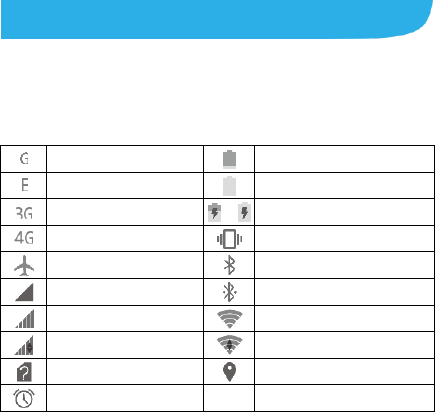
25
Knowing the Basics
Monitoring the Phone Status
The status bar at the top of the home screen provides phone and
service status icons on the right side. Below are some of the
icons you may see.
GPRS connected
Battery low
EDGE connected
Battery full
3G connected
/
Battery charging
4G connected
Vibration mode
Airplane mode
Bluetooth on
No signal
Bluetooth connected
Signal strength
Connected to a Wi-Fi network
Mobile data in use
Wi-Fi in use
No SIM card installed
GPS on
Alarm set
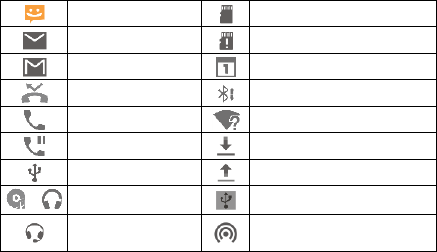
26
Managing Notifications
Notification Icons
The status bar at the top of the home screen provides notification
icons on the left. Below are some of the icons you may see.
New message
microSDHC card unmounted
New email
microSDHC card removed
New Gmail message
Upcoming event
Missed call
Incoming file via Bluetooth
Call in progress
New Wi-Fi network detected
Call on hold
Downloading data
USB connected
Sending data
/
Song is playing
USB tethering is on
Wired headset
connected
Portable Wi-Fi hotspot or Wi-Fi
direct is on
Open/Close the Notification Panel
Notifications report the arrival of new messages, calendar events,
and alarms, as well as ongoing events, such as when you've
configured your phone as a Wi-Fi hotspot. You can open the
notification panel to view the details of notifications.
To open the notification panel, swipe your finger down from
the top of the screen.

27
To close the notification panel, swipe your finger up on the
screen or touch the Back key.
Respond to or Remove a Notification
In the notification panel, you can respond to a notification or
remove the notifications. The notification panel also supports
expandable notifications that let you perform additional actions
right from the notification itself.
To respond to a notification, just touch it.
To remove a notification, swipe it left or right.
Slide down with one finger to expand certain notifications.
You can also swipe two fingers vertically or pinch-zoom to
expand or collapse certain notifications.
To remove all notifications, touch below all the
notifications.
To manage notifications you have received, touch and hold a
notification to identify the application that created it. You can
then touch and select Block to hide future notifications
from this app, or touch Priority to show them in priority mode.
NOTE:
If you turn off notifications for an app, you may miss its important
alerts and updates. The notifications of some apps cannot be
turned off.
Use Quick Settings
The Quick Settings make it convenient to view or change the
most common settings for your phone.

28
Open the notification panel and then drag the panel downwards
to find the following Quick Settings on the screen.
Airplane: Touch to turn on or off the airplane mode.
Auto Rotate: Touch to turn on or off the auto-rotate screen
feature.
Flashlight: Touch to turn on or off the flash.
Wi-Fi: Touch to turn on or off Wi-Fi.
Bluetooth: Touch to turn on or off Bluetooth.
Data: Touch to enable or disable data access over the mobile
network.
Brightness: Uncheck Auto and drag the brightness slider to
adjust the screen brightness.
NOTE:
In the Quick Settings screen, touch at the top to get to the
Settings menu; touch the battery icon to open the battery
settings screen.
Managing Shortcuts and Widgets
Add Shortcuts and Widgets
1. Touch the Home key.
2. To add a widget, touch and hold a blank area of the home
screen and then touch WIDGETS.
To add an application shortcut, touch .
3. Slide left or right to view all available widgets or applications.

29
4. Touch and hold a widget or an application icon and drag it to
a home screen panel.
Move Shortcuts or Widgets
1. Touch and hold a widget or shortcut on the home screen.
2. Drag it to the place you need.
Remove Shortcuts or Widgets
1. Touch and hold a widget or shortcut on the home screen.
2. Drag it to to remove it.
Adjust Widget Size
1. Touch and hold a widget on the home screen and then
release it.
2. An outline appears around the widget. Drag the outline to
resize the widget.
NOTE:
Not all widgets can be resized.
Organizing With Folders
You can create folders on a home screen and put several icons
in a folder.
Create a Folder
1. Touch and hold a shortcut on the home screen.
2. Drag the shortcut icon over another and release your finger. A
30
new folder is created and both shortcuts are added into the
folder.
3. If needed, drag more shortcuts and drop them into the folder.
Rename a Folder
1. Touch a folder to open it. The old folder name is displayed
below the icons.
2. Touch the folder name and enter a new name.
Add More Icons to a Folder
1. Touch and hold an icon and then drag it onto a folder icon.
2. Release the icon and it will be put into the folder.
Remove Icons From a Folder
1. Touch a folder to open it.
2. Touch and hold the icon you want to remove and then drag it
to the home screen.
3. Release the icon and it will be removed from the folder.
Rearranging the Primary Icons
The home screen includes a customizable primary icons area at
the bottom visible from all home screen panels. You can keep at
most five items in the area. Drag icons or folders in or out of the
area to rearrange it.
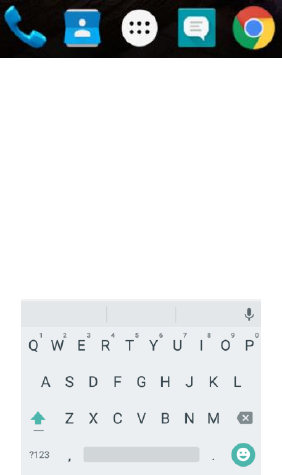
31
Entering Text
You can enter text using the onscreen keyboard. Some apps
open it automatically. In others, you open it by touching where
you want to type. You can touch the Back key to hide the
onscreen keyboard.
Google Keyboard
The Google Keyboard provides a layout similar to a desktop
computer keyboard. Turn the phone sideways and the keyboard
will change from portrait to landscape. The landscape keyboard
is not supported in all applications.
Touch the alphabetic keys to enter letters. Touch and hold
some specific keys to enter associated accented letters or

32
numbers. For example, to enter È, touch and hold and
the available accented letters and number 3 appear. Then
slide to choose è.
Touch to use uppercase. Double-tap to lock
uppercase. This key also changes to indicate the current
case you are using: for lowercase, for uppercase,
and when locked in uppercase.
Touch to delete the text before the cursor.
Touch to select numbers and symbols. You can then
touch to find more.
Touch to enter miniature icons, such as expressions,
horoscopes, and animals.
Touch to use Google voice typing.
Google Voice Typing
Google Voice typing uses the Google voice recognition service to
convert speech to text.
1. Touch to access the voice typing when you are using the
Google Keyboard.
2. When you see the microphone image, speak what you want
to type.
3. You can continue entering text to keep it or to delete it.
NOTE:
Say "comma," "period," "question mark," "exclamation mark," or

33
"exclamation point" to enter punctuation.
Input Settings
Choose input settings by touching Home key > > Settings >
Language & input from the home screen.
In the Keyboard & input methods section, you can set the
default input method and choose the settings for input methods.
Editing Text
Move the insertion point: Touch where you want to type.
The cursor blinks in the new position, and a tab appears
below it. Drag the tab to move the cursor.
Select text: Touch and hold or double-tap within the text. The
nearest word highlights, with a tab at each end of the
selection. Drag the tabs to change the selection.
Cut or copy: Select the text you want to manipulate. Then
touch the Cut / or Copy / button to cut or
copy the text to the clipboard.
Replace text with the clipboard text: Select the text you
want to replace. Then touch , or PASTE.

34
Opening and Switching Apps
Open an App
1. Touch the Home key > .
2. Slide left or right and touch an app to open it.
Switch Between Recently Opened Apps
1. Touch the Recent apps key. The apps you’ve used recently
are displayed in a series of tabs. Slide up and down to see all
the tabs.
2. Touch a tab to open that app.
NOTE:
You can swipe a tab sideways to remove it from the screen.

35
Connecting to Networks and
Devices
Connecting to Mobile Networks
Select Network Operator
1. Touch the Home key > > Settings > More > Cellular
networks.
2. Touch Network operators to search for all available
networks.
3. Touch a network in the network list to register manually.
You can also touch Choose automatically to select
preferred network automatically.
Control Mobile Data Use
You can use or disable the mobile data service of the nano-SIM
card.
To enable or disable data access:
1. Touch the Home key > > Settings > More > Cellular
networks.
2. Touch Mobile Data and then touch Standard Data switch to
enable or disable mobile data use.
To get data services when roaming:
1. Touch the Home key > > Settings > More > Cellular

36
networks.
2. Touch International Data Roaming > International Data.
NOTE:
Data roaming may incur significant roaming charges.
Select Preferred Network Type
Set the preferred type of network for the nano-SIM card.
1. Touch the Home key > > Settings > More > Cellular
networks.
2. Touch Preferred network type and select the network type
you would prefer the phone to connect with.
Set Access Point Names
To connect to the Internet you can use the default Access Point
Names (APN). And if you want to add a new APN, please contact
the service provider to get the necessary information.
1. Touch the Home key > > Settings > More > Cellular
networks.
2. Touch Access Point Names > .
3. Touch each item to enter the information you get from your
service provider.
4. Touch > Save to complete.
NOTE:
To set the APN to default settings, touch > Reset to default.

37
Connecting to Wi-Fi®
Wi-Fi is a wireless networking technology that can provide
Internet access at distances of up to 100 meters, depending on
the Wi-Fi router and your surroundings.
Turn Wi-Fi On and Connect to a Wi-Fi
Network
1. Touch the Home key > > Settings > Wi-Fi.
2. Slide the Wi-Fi switch to the On position to turn on Wi-Fi.
3. Touch a network name to connect to it.
4. If the network is secured, enter the password and touch
CONNECT.
NOTE:
Your phone automatically connects to previously used Wi-Fi
networks when they are in range.
Get Notified of Open Networks
1. Touch the Home key > > Settings > Wi-Fi.
2. Slide the Wi-Fi switch to the On position.
3. Touch the Menu Key > Advanced.
4. Slide the Network notification switch.
When Wi-Fi is on, you receive notifications in the status bar when
your phone detects an open Wi-Fi network. Switch off the option
to turn off notifications.

38
Add a Wi-Fi Network
You can add a Wi-Fi network if the network does not broadcast
its name (SSID) or add a Wi-Fi network when you are out of
range.
To connect to a secured network, you first need to get the
security details from the network's administrator.
1. Touch the Home key > > Settings > Wi-Fi.
2. Slide the Wi-Fi switch to the On position.
3. Touch > Add network.
4. Enter the network SSID (name). If necessary, enter security
or other network configuration details.
5. Touch SAVE.
Connect to a WPS Network
WPS (Wi-Fi Protected Setup) is a feature that makes it easy to
add your phone to access points which support WPS.
You can use one of the following two methods to connect your
phone to a wireless network using WPS.
Method one: WPS button
1. Touch the Home key > > Settings > Wi-Fi.
2. Slide the Wi-Fi switch to the On position.
3. Touch > Advanced > WPS Push Button.
4. Press the WPS button on the access point and the access
point will recognise your phone and add it to the network.

39
Method two: PIN number
1. Touch the Home key > > Settings > Wi-Fi.
2. Slide the Wi-Fi switch to the On position.
3. Touch > Advanced > WPS Pin Entry.
4. The WPS PIN number displays on the screen. Enter the PIN
number into the access point’s setup page.
After entering the PIN number, your phone automatically finds
the access point and configures the connection.
NOTE:
For detailed information about the WPS feature of the access
point, please refer to its user documents.
Forget a Wi-Fi Network
You can make your phone forget about the details of a Wi-Fi
network that you added - for example, if you don’t want the phone
to connect to it automatically or if it is a network that you no
longer use.
1. Touch the Home key > > Settings > Wi-Fi.
2. Slide the Wi-Fi switch to the On position.
3. Touch the Wi-Fi network name and then touch FORGET.
Adjust Advanced Wi-Fi Settings
1. Touch the Home key > > Settings > Wi-Fi.
2. Touch > Advanced to adjust the following settings.

40
Scanning always available: Let Google’s location
service and other apps scan for networks even when
Wi-Fi is off.
Network notification: Get notifications in the status bar
when Wi-Fi is on and an open network is available.
Keep Wi-Fi on during sleep: Set whether to keep Wi-Fi
on in sleep mode.
Install certificates: Install certificates needed for
connecting to certain Wi-Fi networks.
Wi-Fi Direct: Use the Wi-Fi Direct feature.
WPS Push Button: Connect to a WPS network via the
push button method.
WPS Pin Entry: Connect to a WPS network via the
phone PIN method.
MAC address: Check the MAC address.
IP address: Check the phone’s IP address.
Using Wi-Fi Direct®
Wi-Fi Direct allows Wi-Fi devices to share files and data directly
by connecting to each other without the need for wireless access
points (hotspots).
NOTE:
Activating this feature will disconnect your current Wi-Fi network
connection.
1. Touch the Home key > > Settings > Wi-Fi.

41
2. Touch > Advanced > Wi-Fi Direct. Your phone will search
for other devices enabled with Wi-Fi Direct connections.
3. Touch a device name below Peer devices to connect with it.
The other device will receive a connection prompt and need
to accept the request. Both devices may need to enter a
common PIN.
4. Once connected the device is displayed as “Connected” in
the Wi-Fi Direct screen.
Connecting to Bluetooth® Devices
Bluetooth® is a short-range wireless communication technology.
Phones or other devices with Bluetooth capabilities can
exchange information wirelessly within a distance of about 10
meters (32.8 feet). The Bluetooth devices must be paired before
the communication is performed.
Turn Bluetooth On/Off
1. Touch the Home key > > Settings > Bluetooth.
2. Slide the Bluetooth switch to the On or Off position.
When Bluetooth is on, the icon appears in the status bar.
Change the Device Name
1. Touch the Home key > > Settings > Bluetooth.
2. Slide the Bluetooth switch to the On position if Bluetooth is
off.

42
3. Touch > Rename this device.
4. Edit the name and touch RENAME.
Pair With Another Bluetooth Device
1. Touch the Home key > > Settings > Bluetooth.
2. Slide the Bluetooth switch to the On position if Bluetooth is
off.
Your phone automatically scans for and displays the IDs of all
available Bluetooth devices in range. You could touch >
Refresh if you want to scan again.
3. Touch the device you want to pair with.
4. Confirm that the Bluetooth passkeys are the same between
the two devices and touch PAIR. Alternately, enter a
Bluetooth passkey and touch PAIR.
Pairing is successfully completed when the other device
accepts the connection or the same passkey is entered.
NOTE:
The Bluetooth passkey may be fixed for certain devices such as
headsets and handsfree car kits. You can try entering 0000 or
1234 (the most common passkeys) or refer to the documents for
that device.
Send Data via Bluetooth
1. Open the appropriate application and select the file or item
you want to share.
2. Select the option for sharing via Bluetooth. The method may

43
vary by application and data type.
3. Touch a Bluetooth device the phone has paired with or wait
for it to search for new devices and touch one of them.
Receive Data via Bluetooth
1. Turn Bluetooth on before trying to receive data via Bluetooth.
2. Flick down the status bar and touch .
3. Touch ACCEPT to start receiving the data.
Depending on your storage setting and whether a microSDHC
card is installed, received files are stored automatically in a
dedicated folder (Bluetooth, for instance) in the phone storage or
microSDHC directory. You can access them with the File
Manager app. Received contacts (vCard files) are automatically
imported to your contact list.
Connecting to Your Computer via USB
You can connect your phone to a computer with a USB cable and
transfer music, pictures, and other files in both directions. Your
phone stores these files in internal storage or on a removable
microSDHC card.
If you are using USB tethering, you must turn that off before you
can use USB to transfer files between your phone and computer.
Connect Your Phone to a Computer via USB
1. Connect your phone to the PC with a USB cable.
2. Open the notification panel and touch (Connected

44
to/as...).
3. Choose one of the following options:
Media device (MTP): Transfer files on Windows® PC or
Mac®.
Camera (PTP): Transfer photos using camera software.
Mount SD card: Let you transfer media files in the SD
card on computer.
Charging: Charge your phone via USB.
Connect With Windows Media® Player
You can sync music on your phone and the computer installed
with Windows Media Player.
1. Connect the phone with your computer via USB and choose
Media device (MTP).
2. Open Windows Media Player and synchronize music, picture,
and video files.
Disconnect Your Phone From the Computer
To disconnect the phone from the computer, simply unplug the
USB cable when you’re finished.
Remove the microSDHC Card From Your
Phone
If you need to remove the microSDHC card while the phone is on,
you should unmount it first.
1. Touch the Home key > > Settings > Storage >

45
Unmount SD card > OK.
2. The icon appears in the status bar and you can now
safely remove the microSDHC card from the phone.
Erase microSDHC Card
1. Touch the Home key > > Settings > Storage.
2. Scroll down the screen to the SD card section and touch
Erase SD card > ERASE SD CARD > ERASE
EVERYTHING.
CAUTION:
The formatting procedure erases all the data on the microSDHC
card, after which the files CANNOT be retrieved.
Sharing Your Mobile Data Connection
You can share your phone’s data capabilities through tethering or
by activating the mobile hotspot feature to create a portable Wi-Fi
hotspot.
Share Your Mobile Data Connection via USB
You can access the Internet on your computer via the USB
tethering feature of your phone. The feature needs data
connection on a mobile network and may result in data charges.
NOTE:
You cannot transfer files between your phone and your computer
via USB while the phone is USB tethered.

46
1. Connect your phone to your computer with a USB cable.
2. Touch the Home key > > Settings > More > Tethering
& portable hotspot.
3. Touch USB tethering. A new network connection will be
created on your computer.
NOTE:
To stop sharing your data connection, touch USB tethering
again or disconnect the USB cable.
Share Your Mobile Data Connection via
Bluetooth
If your computer can obtain an Internet connection via Bluetooth,
you can configure your phone to share its mobile data connection
with your computer.
1. Pair your phone with your computer via Bluetooth.
2. Configure your computer to obtain its network connection via
Bluetooth. For more information, please see your computer's
documents.
3. Touch the Home key > > Settings > More > Tethering
& portable hotspot.
4. Touch Bluetooth tethering. Your computer is now sharing
your phone's data connection.
NOTE:
To stop sharing your data connection, touch Bluetooth
tethering again.

47
Share Your Mobile Data Connection as a
Wi-Fi Hotspot
You can share your phone’s data connection with other devices
by turning your phone into a portable Wi-Fi hotspot. The feature
needs data connection on a mobile network and may result in
data charges.
NOTE:
When the portable Wi-Fi hotspot feature is enabled, you cannot
use your phone’s Wi-Fi capability to access the Internet. You still
remain connected to the Internet via your mobile data network.
1. Touch the Home key > > Settings > More > Tethering
& portable hotspot.
2. Touch Portable Wi-Fi hotspot.
After a moment, the phone starts broadcasting its Wi-Fi
network name (SSID).
3. On another device, locate your phone via Wi-Fi and connect
with it to start using the phone’s mobile data.
NOTE:
To stop sharing your data connection, touch Portable Wi-Fi
hotspot again.
Rename or Secure Your Wi-Fi Hotspot
You can change the name of your phone's Wi-Fi network (SSID)
and secure your portable Wi-Fi hotspot.
1. Touch the Home key > > Settings > More > Set up

48
Wi-Fi hotspot.
2. Set your name and security options as follows:
Network name: Enter or edit a network SSID (name) that
other devices see when scanning for Wi-Fi networks.
Security: Choose a security option, Open (not
recommended), WPA PSK or WPA2 PSK (other users
can access your mobile hotspot only if they enter the
correct password). When you select WPA PSK or WPA2
PSK, touch the Password field to edit the security
password.
3. Touch SAVE to save your settings.
Connecting to Virtual Private Networks
Virtual private networks (VPNs) allow you to connect to the
resources inside a secured local network. VPNs are commonly
deployed by corporations, schools, and other institutions to let
people access local network resources when not on campus, or
when connected to a wireless network.
Depending on the type of VPN you are using, you may be
required to enter your login credentials or install security
certificates before you can connect to your VPN. You can get this
information from your network administrator.
Add a VPN
1. Touch the Home key > > Settings > More > VPN.
2. Touch + and fill in the information provided by your network
administrator.

49
3. Touch SAVE.
The VPN is added to the list on the VPN screen.
Connect to a VPN
1. Touch the Home key > > Settings > More > VPN.
2. Touch the VPN that you want to connect to.
3. When prompted, enter any requested credentials, and then
touch CONNECT.
When you are connected, the VPN connected icon appears in
the status bar.
Modify a VPN
1. Touch the Home key > > Settings > More > VPN.
2. Touch and hold the VPN that you want to modify.
3. Touch Edit profile and edit the VPN settings you want.
4. Touch SAVE.

50
Phone Calls
You can place calls from the Phone app, the People app, or other
apps or widgets that display contact information. Wherever you
see a phone number, you can usually touch it to dial.
Placing and Ending Calls
Place a Call by Dialing
1. Touch the Home key > .
2. Touch , enter the phone number with the on-screen
keypad. Touch to delete incorrect digits.
NOTE:
As you enter digits, your phone searches for contacts that
match. If you see the number you want to dial, touch it to
place the call immediately without entering the rest of the
number.
3. Touch below the keypad to dial.
You can also touch the search box at the top of the Phone app
screen and enter the phone number or contact name you want to
call. Touch the matching contact or Call [number] to place the
call.
NOTE:
To make an international call, touch and hold the 0 key to enter

51
the plus (+) symbol. Next, enter the country code, followed by the
city/area code and then the phone number.
NOTE:
To redial the last call you made, just touch the Home key > >
> and touch again.
End a Call
During a call, touch on the screen.
Answering or Rejecting Calls
When you receive a phone call, the Incoming Call screen opens,
displaying the Caller ID or the information about the caller that
you've entered in the Contacts app. You can answer or reject
the call, or reject it with a text message.
Answer a Call
When you receive a phone call, drag over to answer the
call.
NOTE:
To silence the ringer before answering the call, press the
Volume Key.
Reject a Call
When you receive a phone call, drag over to reject the
call.

52
You can also drag over to reject the call and send a
preset text message to the caller.
NOTE:
To edit the text response from within the Phone app, touch in
the top search field and select Settings > General settings >
Quick responses.
Working With the Call Log
The call history is a list of all the calls you've placed, received, or
missed. It provides a convenient way to redial a number, return a
call, or add a number to your Contacts.
To open the call history, you can touch the Home key > >
(in the top search field) > Call History.
Place a Call From the Call History
1. Open the call history.
2. Touch a number and select CALL BACK.
NOTE:
You can touch the STATISTICS tab and then touch to filter
the records by call type.
Take Other Actions on a Call History Entry
Open the call history and touch a number.

53
Touch DETAILS to view more call information. While viewing
the call details, you can touch > Edit number before call
to edit the number in the dialer before calling it.
Touch the contact icon in front of the entry to open the contact
information tab from the bottom, where you can send a
message, call back, edit the contact, add the contact to
favorites, or add the number to contacts.
NOTE:
You can touch > Clear call log in the call history screen to
delete all history records.
Calling Your Contacts
1. Touch the Home key > . Your favourite contacts and
frequently called contacts are displayed in the SPEED DIAL
tab.
2. Touch a contact to place the call, or touch or swipe to the
CONTACTS tab to view all your contacts with phone
numbers and touch to make a call.
Checking Voicemail
If you have set the phone to divert calls to voicemail, callers can
leave voicemail messages when they cannot reach you. Here’s
how to check the messages they left.
1. Touch the Home key > > .
2. Touch and hold “1” in the dialer. If prompted, enter your

54
voicemail password.
3. Follow the voice prompts to listen to and manage your
voicemail messages.
NOTE:
See Set Voicemail for how to set your voicemail service. For
detailed information, please contact the service provider.
Using Options During a Call
During a call, you will see a number of onscreen options. Touch
an option to select it.
Touch to turn on or off the speaker.
Touch to mute or unmute your microphone.
Touch to make another call separately from the first call,
which is put on hold.
Touch to switch to the keypad when you need to enter a
code (for example, the PIN for your voicemail or bank
account) during the call.
Touch to put the call on hold.
Touch the Menu Key > Record to record phone
conversation.
Touch to merge the separate calls into a single
conference call.
WARNING!

55
Because of higher volume levels, do not place the phone near
your ear during speakerphone use.
Managing Multi-party Calls
When the call waiting and three-way call features are available,
you can switch between two calls or set up a conference call.
NOTE:
The call waiting and three-way call features need network
support and may result in additional charges. Please contact your
service provider for more information.
Switch Between Current Calls
When you’re on a call and another call comes in, your phone
screen informs you and displays the caller ID.
To respond to an incoming call while you’re on a call:
Drag over to answer the call. (This puts the first caller
on hold and answers the second call.)
To switch between two calls:
Touch the tab at the bottom (displayed as “On hold”) to switch
back to the other call.
Set Up a Conference Call
With this feature, you can talk to two people at the same time.
1. Place the first call.
2. Once you have established the connection, touch and

56
dial the second number. (This puts the first caller on hold.)
3. When you’re connected to the second party, touch .
If one of the people you called hangs up during your call, you and
the remaining caller stay connected. If you initiated the call and
are the first to hang up, all callers are disconnected.
To end the conference call, touch .
Adjusting Your Call Settings
Set Contact Display Options
You can set the order of the contacts displayed in the
CONTACTS tab of the Phone app.
1. Touch the Home key > > (in the top search field) >
Settings > General settings.
2. Touch Sort by or Name format to set the order of the
contacts and the format of the contact names.
Set Sound and Vibration
Set the sound and vibration for incoming calls as well as dialpad
sounds.
1. Touch the Home key > > (in the top search field) >
Settings > General settings.
2. In the Sounds and vibrate section, touch the option you
want to configure.
Check Dialpad tones to play sounds when you touch the
dialpad keys.

57
Check Also vibrate for calls to enable vibration for
incoming call notification.
Edit Quick Response to Rejected Callers
1. Touch the Home key > > (in the top search field) >
Settings > General settings > Quick responses.
2. Touch a text message to edit it.
Set Voicemail
1. Touch the Home key > > (in the top search field) >
Settings > Call settings.
2. Touch Voicemail to configure voicemail settings.
Touch Service to select the voicemail service provider.
Your carrier is the default.
Touch Setup > Voicemail number to edit the voicemail
number.
Touch Sound to select the notification sound for new
voicemails.
Check Vibrate to enable vibration for notification.
3. Touch Voicemail settings > Voicemail number to edit the
voicemail number if necessary.
Use Fixed Dialing Numbers
Fixed Dialing Numbers (FDN) allows you to restrict outgoing calls
to a limited set of phone numbers.
1. Touch the Home key > > (in the top search field) >

58
Settings > Call settings.
2. Touch Fixed Dialing Numbers and the following options are
available:
Enable FDN: Input the PIN2 code to enable the FDN
feature.
Change PIN2: Change the PIN2 code for FDN access.
FDN list: Manage the FDN list.
NOTE:
The PIN2 code is provided by your carrier. Entering an incorrect
PIN2 code more times than allowed can get your micro-SIM card
locked. Contact the service provider for assistance.
Forward Incoming Calls
Call forwarding feature allows you to forward your incoming calls
to another phone number.
1. Touch the Home key > > (in the top search field) >
Settings > Call settings.
2. Touch Call forwarding.
3. Touch an available option ( Always forward, When busy,
When unanswered, or When unreachable) to enable it.
Set TTY Mode
Select a TTY mode for your phone to work with a teletypewriter,
or turn TTY off.
1. Touch the Home key > > (in the top search field) >
Settings > Call settings > TTY mode.

59
2. Select one of the following options. Consult your
teletypewriter manufacturer’s manual if necessary.
TTY Off: Users who can hear and talk can disable TTY
support.
TTY Full: Users who cannot talk or hear may use this
mode to send and receive text messages through a TTY
device.
TTY HCO: Users who can hear, but cannot talk, may use
this mode to listen to conversation of the other party and
respond via text messages.
TTY VCO: Users who can talk, but cannot hear, may use
this mode to talk through the phone and receive
responses via text messages.
Set DTMF Tones
You can set the length of Dual-tone multi-frequency (DTMF)
signal tones.
1. Touch the Home key > > (in the top search field) >
Settings > Call settings > DTMF tones.
2. Touch Normal or Long.
Set Speed Dials
You can touch and hold the 1 ~ 9 keys from the dialer to call the
corresponding speed dial number.
The number key 1 is reserved to speed dial your voicemail.
To assign a speed dial key:

60
1. Touch the Home key > > (in the top search field) >
Settings > Call settings > Speed dial.
2. Touch a speed dial key.
3. Enter a phone number or select one from the contact list.
4. Touch OK.
Bar Certain Calls
Call barring feature allows you to forbid certain types of calls from
your phone.
1. Touch the Home key > > (in the top search field) >
Settings > Call settings > Call Barring Settings.
2. Set the restriction of specific types of calls from your phone.
Other Options
1. Touch the Home key > > (in the top search field) >
Settings > Call settings > Additional settings.
2. Touch Caller ID to choose whether your number is displayed
when someone receives your outgoing call. Or check Call
waiting to get notified of incoming calls during a call.
NOTE:
Please contact the service provider to check whether the caller
ID and call waiting features are available.
Internet Call Settings
To add an Internet calling account:

61
1. Touch the Home key > > (in the top search field) >
Settings > Call settings > Phone account settings > SIP
accounts.
2. Touch ADD ACCOUNT.
3. Follow the instructions from your Internet calling service
provider to configure the settings for your account.
4. Touch SAVE.
To configure which calls use Internet calling:
You can configure your phone to place all calls using Internet
calling, just calls to Internet calling addresses, or to ask each time
you place a call.
1. Touch the Home key > > (in the top search field) >
Settings > Call settings > Phone account settings.
2. Touch Use SIP calling.
3. Touch the Internet calling option you want.
To configure your phone to receive Internet calls:
By default, your phone is configured to make Internet calls, but
not to ensure that you will receive them. However, you can
configure your phone to listen for Internet calls made to an
Internet calling account you have added to your phone.
1. Touch the Home key > > (in the top search field) >
Settings > Call settings > Phone account settings.
2. Check Receive incoming calls. Checking this setting will
reduce your battery life between charges.

62
Contacts
You can put contacts on your phone and synchronize them with
the contacts in your Google account or other accounts that
support contact syncing.
To see your contacts, touch the Home key > . From there,
you can touch the tabs on the top of the screen to quickly switch
to contact groups or favorite contacts.
Checking Contact Details
1. Touch the Home key > and touch the ALL CONTACTS
tab to access your contact list.
2. Scroll through the list to view all your contacts.
3. Touch a contact to view its details.
NOTE:
If you have a lot of contacts stored, you'll see a slider on the right
side of the screen. Drag the slider to the letter initial you need.
Adding a New Contact
1. Touch the Home key > and touch the ALL CONTACTS
tab.
2. Touch to add a new contact.

63
3. Touch the account field near the top of the screen to choose
where to save the contact. If a sync account is selected, the
contacts will be synced automatically with your account
online.
4. Enter the contact name, phone numbers, email addresses,
and other information.
5. Touch to save the contact.
Setting Up Your Own Profile
You can create your own name card in your phone.
1. Touch the Home key > and touch the ALL CONTACTS
tab.
2. Touch Set up my profile.
3. Enter your profile information. Touch ADD ANOTHER FIELD
to add more information if you want.
4. Touch .
Importing, Exporting, and Sharing
Contacts
You can import/export contacts from/to your micro-SIMs or
microSDHC card. This is especially useful when you need to
transfer contacts between different devices. You can also quickly
share contacts using Bluetooth, Google Drive, Email, Gmail, or
Messaging.

64
Import Contacts From the micro-SIM Cards
1. Touch the Home Key > .
2. Touch > Import/export > Import from SIM card.
3. Touch to select the contacts you need and then touch .
Import Contacts From the microSDHC Card
1. Touch the Home Key > .
2. Touch > Import/export > Import from storage.
3. Select an account in which to save the contacts.
4. Select the vCard file(s) and touch OK.
Export Contacts to the micro-SIM Card
1. Touch the Home Key > .
2. Touch > Import/export > Export to SIM card.
3. Touch to select the contacts you need and then touch .
Export Contacts to the Storages
1. Touch the Home Key > .
2. Touch > Import/export > Export to storage.
3. The phone will prompt you with the name of the vCard file.
Touch OK to create the file on the microSDHC card or the

65
phone storage.
Working With Favorite Contacts
In the favorite contacts tab, you can find your favorite contacts
and frequently contacted contacts.
Add a Contact to Favorites
You can add the contacts you use frequently to FAVORITES so
that you can find them quickly.
1. Touch the Home key > and touch the ALL CONTACTS
tab.
2. Touch a contact and then touch at the top.
Remove a Contact From Favorites
1. Touch the Home key > and touch the FAVORITES tab.
2. Touch a favorite contact and then touch next to the
contact name.
Working With Groups
View Your Contact Groups
1. Touch the Home key > and touch the GROUPS tab.
2. Scroll through the list to view the preset groups and any

66
groups you have created.
3. Touch a group to view its members.
NOTE:
Touch the Menu Key > Send Group message / Send Group
email to send messages or emails to selected group members.
Set Up a New Group
1. Touch the Home key > and touch the GROUPS tab.
2. Touch to create a new group.
3. Touch the drop-down box near the top of the screen, which
will be there if you have added accounts to the phone, to
choose an account for the group.
4. Enter a group name.
5. Touch Add member and select the contacts you wish to be
the group members.
6. Touch .
7. Touch the field below RINGTONE to select the ringtone for
incoming calls from the group members.
8. Touch OK.
9. Touch to save the group.
Delete a Group
1. Touch the Home key > and touch the GROUPS tab.

67
2. Touch a group and then touch > Delete.
3. Touch OK to disband the group. The contacts in the group
will not be deleted.
Edit a Group
1. Touch the Home Key > and touch the GROUPS tab.
2. Touch a group and then touch the Menu Key > Edit.
3. Touch the group name to edit it, or touch the field below
MEMBER or RINGTONE to add more members or change
the ringtone.
NOTE:
To remove group members, touch a group in the GROUPS tab
and touch the Menu Key > Multi-Select to choose members.
Then touch > OK.
Searching for a Contact
1. Touch the Home key > .
2. Touch at the top of the screen.
3. Input the contact name or any information the contact has to
search for it. The contacts matched will be listed.

68
Editing Contacts
Edit Contact Details
1. Touch the Home key > .
2. Touch a contact you need to edit and then touch .
3. Edit the contact and touch .
Set a Ringtone for a Contact
Assign a special ringtone to a contact, so you know who is
calling when you hear the ringtone.
1. Touch the Home key > .
2. Touch a contact you want to set a ringtone for and then touch
> > Set ringtone.
3. Select a ringtone you like and touch OK.
Delete Contacts
1. Touch the Home key > .
2. Touch > Delete.
3. Touch to select the contacts you want to remove and then
touch .
4. Touch OK to confirm.

69
Join Contacts
As your phone synchronizes with multiple online accounts, you
may see duplicate entries for the same contact. You can merge
all the separate information of a contact into one entry in the
Contacts list.
1. Touch the Home key > .
2. Touch a contact entry to display the contact’s details and then
touch .
3. Touch > Join.
4. Touch the contact whose information you want to join with the
first entry and then touch .
The information from the second contact is added to the first, and
the second contact is no longer displayed in the ALL
CONTACTS list.
You can repeat these steps to join another contact to the main
contact.
Separate Contact Information
If contact information from different sources was joined in error,
you can separate the information back into individual contacts on
your phone.
1. Touch the Home key > .
2. Touch a contact entry you have merged and want to
separate.

70
3. Touch .
4. Touch > Separate.
5. Touch OK to confirm.

71
Accounts
Adding or Removing Accounts
You can add multiple Google Accounts and Microsoft Exchange
ActiveSync® accounts. You may also add other kinds of
accounts depending on the apps installed on your phone.
Add an Account
1. Touch the Home key > > Settings > Accounts > Add
account.
2. Touch the type of account you want to add.
3. Follow the onscreen steps to enter the information about the
account. Most accounts require a username and password,
but the details may vary. You may also need to obtain some
information from IT support or your system administrator.
When the account is successfully added, it is displayed in the
Accounts list.
Remove an Account
Removing an account will delete it and all information
associated with it from your phone, such as emails and
contacts.
1. Touch the Home key > > Settings > Accounts.
2. Touch the account category in the list and then touch the

72
account.
3. Touch > Remove account > REMOVE ACCOUNT.
Configuring Account Sync
Configure Auto Sync Setting
1. Touch the Home key > > Settings > Accounts.
2. Touch and check or uncheck Auto-sync data.
When automatic sync is turned on, changes you make
to information on your phone or on the web are
automatically synced with each other.
When auto sync is turned off, you need to sync manually
to collect emails, updates, or other recent information.
Sync Manually
1. Touch the Home key > > Settings > Accounts.
2. Touch the account category and then the account you want
to sync.
3. Touch > Sync now.
Change an Account’s Sync Settings
1. Touch the Home key > > Settings > Accounts.
2. Touch the account category and then the account. The
73
Sync screen appears, showing a list of information the
account can sync.
3. Check or uncheck items as you need. Checked types of
information on the phone and the web will be kept in sync
when auto-sync is turned on.

74
Email
Touch Email in the home screen to receive and send emails
from your webmail or other accounts, using POP3 or IMAP, or
access your Exchange ActiveSync account for your corporate
email needs.
Setting Up the First Email Account
1. When you open Email for the first time, enter your email
address and password.
2. Touch NEXT to let the phone retrieve the network parameters
automatically.
NOTE:
You can also enter these details manually by touching
MANUAL SETUP or when automatic setup fails.
3. Follow the on-screen instructions to finish the setup.
Your phone will show the inbox of the email account and start to
download email messages.
Checking Your Emails
Your phone can automatically check for new emails at the
interval you set when setting up the account.
You can also check new emails manually by dragging down on

75
the message list.
To check earlier emails for your IMAP or POP3 accounts, swipe
upwards to the bottom of the message list and touch Load
more.
Responding to an Email
You can reply to or forward a message that you receive. You
can also delete messages and manage them in other ways.
Reply to or Forward an Email
1. Open the email you want to reply to or forward from Inbox.
2. Do the following as you need.
To reply to the sender, touch .
To reply to the sender and all recipients of the original
email, touch > Reply all.
To forward the email to someone else, touch >
Forward.
3. Edit your message and touch .
Mark an Email as Unread
You can return a read email to the unread state—for example,
to remind yourself to read it again later. You can also mark a
batch of emails as unread.
While reading a message, touch .

76
While in a message list (for instance, the inbox), touch the
sender images before the messages and then touch .
Delete an Email
You can delete an email from its folder. You can also delete a
batch of emails.
While reading a message, touch .
While in a message list (for instance, the inbox), touch the
sender images in front of the messages and then touch .
Writing and Sending an Email
1. Open your email Inbox and touch .
NOTE:
If you have more than one email account added on the
phone, touch the sender line to select the account you want
to use for sending the message.
2. Enter a contact name or email address in the ‘To’ field.
Separate each recipient with a comma. You can also touch
to select recipients from your contacts.
3. Enter the email subject and compose the email text.
4. Touch to add audio files, images, videos and other
types of files as attachments.
5. Touch to send the message.

77
Adding and Editing Email Accounts
Add an Email Account
After setting up your first email account (see Setting Up the
First Email Account), you can add more email accounts and
manage them separately.
1. Open Email to get the Inbox screen.
2. Touch the Menu Key > Settings > ADD ACCOUNT.
3. Follow the prompts to set up the account as you did with the
first one.
Edit an Email Account
You can change a number of settings for an account, including
how often you check for email, how you’re notified of new mails,
your email signature, and details about the servers the account
uses to send and receive mails.
1. Open Email to get the Inbox screen.
2. Touch the Menu Key > Settings and touch the account
whose settings you want to change.
3. Make the changes you want and touch the Back Key when
you finish.
Changing General Email Settings
General settings apply to all email accounts you add.
78
1. Open Email to get the Inbox screen.
2. Touch the Menu Key > Settings > General.
3. Make the changes and touch the Back Key when you
finish.

79
Messaging
You can use Messaging to exchange text messages (SMS) and
multimedia messages (MMS).
Opening the Messaging Screen
Touch in the home screen.
The Messaging screen opens where you can create a new
message, search for messages, or open an ongoing message
thread.
Touch to write a new text or multimedia message.
Touch to search for a message using keywords.
Touch an existing message thread to open the conversation
you’ve had with a certain number.
Sending a Message
1. On the Messaging screen, touch at the bottom.
2. Add recipients by one of the following ways.
Touch the To field and manually enter the recipient’s
number or the contact name. If the phone presents a few
suggestions, touch the one you want to add.
Select recipients from your contacts or call log by

80
touching .
3. Touch the Type message field and enter the content of your
message.
4. If you want to send a multimedia message, touch > Add
subject to add a message subject or touch the paper clip
icon to attach a file or a slideshow to the message.
5. Touch .
NOTE:
You can also include email addresses as recipients for
multimedia messages.
NOTE:
Do not add a message subject or any attachment if you want to
send a text message. Otherwise you may be charged for a
multimedia message.
Replying to a Message
Messages you receive are appended to existing threads for the
same number. If the new message comes from a new number,
a new thread is created.
1. On the Messaging screen, touch the thread that has the
message you want to reply to.
2. Type your reply in the text box at the bottom. You can touch
the attach icon if you want to reply with an MMS.

81
3. Touch .
Forwarding a Message
1. On the Messaging screen, touch the thread that has the
message you want to forward.
2. Touch the message.
3. Touch Forward in the menu that opens.
4. Enter a recipient for the message and edit the content if you
want.
5. Touch .
Changing Messaging Settings
Touch > Settings in the Messaging screen to change
messaging settings.

82
Calendar
Calendar on the phone works with the web-based Google
Calendar™ service for creating and managing events,
meetings, and appointments. It also works with the Microsoft
Exchange ActiveSync calendar once you sign into your
Exchange account on the phone.
To open Calendar, touch the Home key > > Calendar.
Viewing Your Calendars and Events
Select Visible Calendars
1. Open the Calendar app.
2. Touch > Calendars to display.
3. In the new screen, touch the calendars to check the
calendars you want to see or uncheck the calendars you’d
like to hide.
Events from hidden calendars are not shown in the Calendar
app.
Change Calendar Views
You can view your calendars in different forms. The app offers
four views: Month, Week, Day, and Agenda.
To change calendar views, touch the time period shown at the

83
top left and select the view you prefer.
You can also change to Day view from Month view by touching
any day block.
In Month view, swipe vertically to see previous months and
future months.
In Week or Day view, swipe horizontally to see previous
weeks/days and future weeks/days.
When you are viewing past or future days, weeks, or
months, touch at the top to quickly switch to today.
View Event Details
In Agenda, Day, or Week view, touch an event to view its
details.
In Month view, touch a day to switch to Day view. Then touch an
event to view its details.
Creating an Event
1. In any Calendar view, touch .
You can also touch a spot in Day or Week view twice to add
an event to that time spot.
2. If you have more than one calendar account, touch the
current account above the Event name box to choose one.
3. Enter the event details and touch DONE.
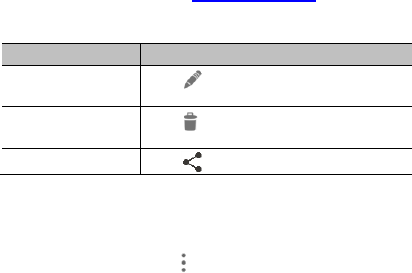
84
Editing, Deleting or Sharing an Event
1. Find the event you want to edit or delete.
2. Open its details screen (see View Event Details in this
chapter).
3. Do one of the following as you need.
To…
do…
Edit the event,
touch at the top of the screen. Touch
DONE to save your changes.
Delete the event,
touch at the top of the screen and then
touch OK.
Share the event,
touch and choose how to share.
Changing Calendar Settings
To change Calendar settings, open a Calendar view (Day, Week,
Month, or Agenda) and touch > Settings.
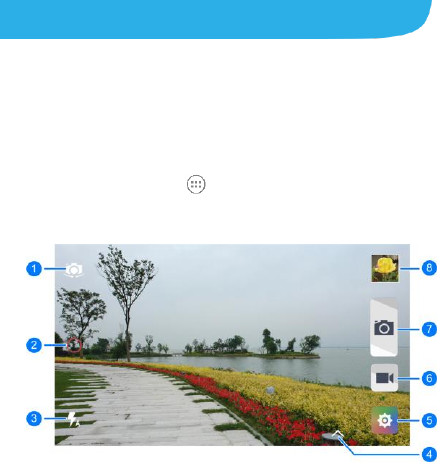
85
Snapdragon Camera
You can use your phone to take photos and record videos.
Photos and videos are stored on the phone’s microSDHC card
or in the phone’s internal storage.
Capturing a Photo
1. Touch the Home key > > Snapdragon Camera.
2. Aim the camera at the subject and make any necessary
adjustment.
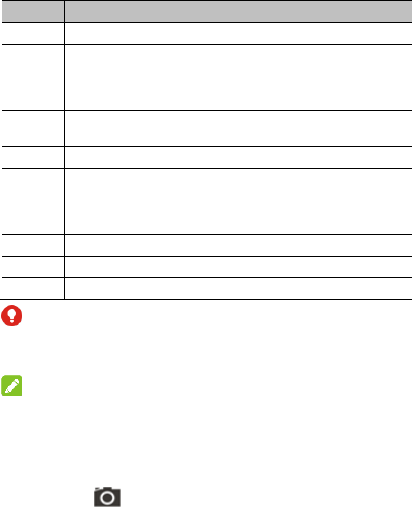
86
Number
Function
1
Switch between the front and back cameras.
2
Switch between simple mode and expert mode. In expert
mode, you will have more options to configure, including
gradienter, exposure, ISO, and white balance. Only
available for the back camera.
3
Change the flash setting, only available for the back
camera.
4
Select color effect, only available for the back camera.
5
Change the camera modes including normal, auto, HDR,
panorama, beautify, smile, photo clear, group, and
straighten. Or configure camera settings. Some modes are
only available for the back camera.
6
Capture a video.
7
Capture a picture.
8
View pictures and videos you have taken.
WARNING!
Keep a safe distance when using the flash. Do not point the
flash towards the eyes of people or animals.
NOTE:
You can spread or pinch on the screen or press the Volume
Key to zoom in or out before taking pictures.
3. Touch the area where you want the camera to focus, or
leave the camera to autofocus on the center of the image.
4. Lightly touch .

87
Recording a Video
1. Touch Camera in the home screen.
2. Aim the camera at the subject. You can touch any area on
the screen that you want the camcorder to focus on before
and during recording.
NOTE:
You can spread or pinch on the screen or press the Volume
Key to zoom in or out before and during recording.
3. Touch to start recording.
4. Touch to stop recording.
NOTE:
While the recording is in progress, you can touch to save
the frame as a separate photo.
Customizing Camera/Camcorder
Settings
Before recording a video, you can touch > to open the
following camera and camcorder setting options.
NOTE:
Not all options are available for the front camera or the back
camera.

88
Camera options
Picture size: Set the image size for your photo.
Grid: Show or hide the composition line.
Self-timer: Set a time delay before the camera takes a
picture automatically after you touch the shutter icon, or
turn off this feature.
Interval: Take a series of pictures at the interval you set
or turn off this feature.
Mirror: Mirror the pictures you take with the front camera.
Face detection: Automatically find people’s faces in the
pictures.
Touching capture: Touch the screen to capture a picture
with the back camera.
Camcorder options
Video quality: Set the quality for your video.
Time lapse: Set the time interval between each frame
when you shot time lapse videos with the back camera.
Silence camcorder: Enable this option if you want to
capture silent video clips.
HFR: Capture silent slow-motion videos.
Other options
Shutter tone: Turn on or off the shutter sound for photo
taking and video recording.
Geo-tagging: Select whether to store the GPS location in
89
your captured photos and videos.
Storage location: Change the storage location for
captured photos and videos.
Restore defaults: Restore default camera settings.

90
More Apps
Clock
Touch the Home key > > Clock. The Clock app allows you
to check local time and time in other cities in the world, set
alarms, and use timers.
Set a New Alarm
1. Touch the tab in the Clock app.
2. Touch an existing alarm to configure it, or touch at the
bottom of the screen to create a new alarm.
3. Set up the alarm options, such as time, repeat, and alarm
sound.
NOTE:
To enable or disable existing alarms directly, just slide the
switches on the right side.
Check World Time
Touch the tab in the Clock app to check local time for
cities around the world.
Touch at the bottom to add a new city or country.

91
Use the Stopwatch and Countdown
Touch the or tab in the Clock app to use the
countdown timer or the stopwatch.
Stopwatch allows you to record lap times, while countdown
timer allows you to set a time and count down to zero.
Backup and Restore
Touch Backup in the home screen. You can back up your user
data, such as contacts and messages, and installed
applications to the memory card regularly. If the data get lost,
restore it from the memory card.
Touch > Help to view detailed guide.
Calculator
Touch the Home key > > Calculator to use the phone’s
convenient built-in calculator for some basic as well as advanced
mathematical equations.
NOTE:
Slide left or right to switch between different panels.
Downloads
The Downloads app keeps a record of the files you have
downloaded using apps such as Browser or Email.

92
Touch the Home key > > Downloads to check the record.
Touch a file to open it with the appropriate applications.
Touch and hold a file to delete or share it.
File Manager
Quickly access all of your images, videos, audio clips, and other
types of files on your phone storage and the microSDHC card.
Touch the Home key > > File Manager. You can find the
file you need by category.
Touch folders and files to access stored items.
Touch and hold an item to access option icons such as Copy,
Move, Share, or Delete.
To copy or move an item, navigate to a new location and
touch PASTE.
Touch to create a new folder in the current directory.
News and Weather
News & Weather offers weather forecasts and news stories
about common topics. You can also customize the news topics
that are displayed.
Touch News & Weather in the home screen. Swipe left or right
to view the weather forecasts and news headlines under
different news topics.

93
Touch the Menu Key to refresh news and forecast data, or to
change the settings.
Sound Recorder
Sound Recorder enables you to record voice memos and
listen to them whenever you like.
Record a Voice Memo
1. Touch the Home key > > Sound Recorder in the home
screen.
2. Touch to start recording.
You can touch to pause and to continue during
the recording.
3. Touch to stop recording. The memo is automatically
saved.
If you don’t want to save the memo after recording it, touch
Discard to delete it.
Play a Voice Memo
To play a memo you just recorded:
Touch at the bottom of the screen.
Task Manager
Touch the Home Key > Task Manager to view or stop

94
applications.
Touch a task in the Tasks tab to check the details of the
application or force it to stop.
Touch the Apps tab to manage all the apps on your phone.
Touch the Resources tab to view the real-time use of the
system resources (CPU, RAM and storages).
Google Apps
Open the Google apps to use Google services. Some apps are
put in the Google folder on the home screen.
NOTE:
Some contents or Google services may not be available in your
region.
Google: Use Google search or get information when you
need it with Google Now.
Chrome: Use the Chrome app to browse the Internet and
get your bookmarks, browsing history, and more synced
with your Google account.
Gmail: Use the Gmail service to send and receive emails.
Google+: Socialize with friends on the Google+ online
community.
Maps: Find your place and find your way in the world.
Play Music: Play music on the phone and on your Google
account.
95
Play Movies & TV: Purchase, download and watch the
latest and your favorite movies and TV shows.
Play Books: Buy and read the electronic version of new
and classic books.
Play Newsstand: Purchase and read newspapers and
magazines.
Play Games: Buy and play games from the Google Play
Store.
Drive: Store files on the Google servers.
YouTube: Watch video clips from YouTube.com, or upload
your own and share with the world.
Photos: Manage photos on the phone and your Google
account.
Hangouts: Chat with Google+ friends or send text or
multimedia messages.
Play Store: Buy and download apps, games, and other
content from the Google Play Store.
Voice Search: Search for information with your voice.

96
Settings
Touch the Home key > > Settings. The Settings app
contains most of the tools for customizing and configuring your
device.
Wireless and Networks
Wi-Fi
Turn Wi-Fi on or off and configure your Wi-Fi connections. See
Connecting to Wi-Fi.
Bluetooth
Turn Bluetooth on or off and configure your Bluetooth
connections. See Connecting to Bluetooth Devices.
Data Usage
Touch the switches to turn on or off mobile data and data limit.
You can check how much data has been used during the time
cycle you set, set a mobile data limit and warning, see what
apps have been using mobile data, or restrict background data
for individual apps.
NOTE:
The data usage is measured by your phone. Your carrier’s data

97
usage accounting may differ.
Airplane Mode
In the Settings app, touch More > Airplane mode. All the
phone’s radios that transmit voice or data are turned off.
Default SMS App
In the Settings app, touch More > Default SMS app to choose
the preferred application for sending and receiving SMS.
Tethering and Portable Hotspot
In the Settings app, touch More > Tethering & portable
hotspot to share your phone’s mobile data connection with
PCs or other devices via USB, Bluetooth or Wi-Fi. See Sharing
Your Mobile Data Connection.
VPN
In the Settings app, touch More > VPN to set up and connect
to virtual private networks. See Connecting to Virtual Private
Networks.
Cellular Networks
In the Settings app, touch More > Cellular networks to control
mobile data use, select mobile network and set access point
names. See Connecting to Mobile Networks.

98
Device
Display
Brightness level: Set the brightness of the display.
Adaptive brightness: Automatically adjust screen
brightness.
Wallpaper: Select a background image for the Home
Screen.
Sleep: Set the length of time of inactivity before the screen
turns off.
Daydream: Manage the Daydream function. When
Daydream is enabled, photos or animations will be
displayed as a screensaver.
Font size: Set the font size of the text on the screen.
When device is rotated: Select whether the screen
contents should rotate when the phone is rotated.
Pulse notification light: Flash the LED light to notify you of
missed calls, new messages, and other events.
Cast screen: Connect with TVs, projectors or other devices
that support wireless display and project your phone’s content
wirelessly to that device. You need to turn on Wi-Fi first. For
detailed introduction, please refer to the device manual.
Sound & notification
Adjust different types of volume (see Adjusting Volume), toggle

99
sound and mute (see Switching to Silent or Vibration Mode), set
up ringtone and notification sound (see Changing Ringtone and
Notification Sound), and select system sounds or control
notification display.
Storage
The Storage settings menu lets you manage the phone storage
and provides options for your microSDHC card.
Save location
This menu allows you to choose the default location for new
data, such as files downloaded, photos captured, and voice
recorded.
1. Touch the Home key > > Settings > Storage > Save
location.
2. Touch Phone to store items in the phone's memory.
- or -
If a microSDHC card is present, touch SD card to store data
on the card.
Internal storage
You can install apps into the internal storage. When you
connect your phone to your computer, only the Internal SD
card is accessible from your computer.
To view the internal storage:
Touch the Home key > Settings > Storage and scroll to
the Internal storage section.

100
Phone storage
The phone storage is part of the internal storage where you can
store your files. You can view this storage space and format
(erase) this storage.
When you connect your phone to your computer, this storage is
accessible and you can copy files between them.
To view the phone storage space:
Touch the Home key > Settings > Storage and scroll to
the Phone storage section.
To erase the phone storage:
1. Touch the Home key > Settings > Storage and scroll
to the Phone storage section.
2. Touch Erase phone storage > ERASE PHONE
STORAGE > ERASE EVERYTHING.
NOTE:
The formatting procedure erases all the data in the phone
storage, after which the files CANNOT be retrieved. To prevent
the loss of important data, please check the contents before
you format the storage.
SD card
The external SD card storage options let you view the
microSDHC card’s size and available space, unmount the card
for safe removal from the phone, and format (erase) the card.
For details, see Remove the microSDHC Card From Your
Phone and Erase microSDHC Card.

101
Battery
Check how much power remains for the battery and what has
been using the battery.
Apps
See apps installed on your phone and manage them.
Touch an app in the DOWNLOADED, ON SD CARD,
RUNNING, or ALL tab to see its information. You can stop the
app, uninstall the app, clear data and cache, or move the app
between the internal storage and the phone storage.
NOTE:
Not all applications can be moved or uninstalled.
Connect to PC
Select your USB connection type between your phone and PC.
See Connecting to Your Computer via USB.
Personal
Location
Activate location services to determine your location. To use
location-related applications, such as finding your location on
Google Maps, you must have location services turned on on
your phone.
1. Touch the Home key > > Settings > Location.

102
2. Slide the Location switch at the top to turn location services
on or off.
3. When location is enabled, touch Mode to select location
sources you want to use.
High accuracy: Get accurate location using both GPS
and Wi-Fi as well as mobile networks.
Battery saving: Use only Wi-Fi and mobile networks to
get your approximate location. This will drain less power
from your battery than using GPS.
Device only: Use GPS to pinpoint your location.
Security
Screen lock: Disable the screen lock or enable it with swipe,
face unlock, pattern, PIN, or password. See Protecting Your
Phone With Screen Locks.
Owner info: Set the text that you may display on the lock
screen.
Lcokscreen shortcuts: Tap an icon on the left or right to
reassign a lock screen shortcut.
Smart Lock: Keep the phone unlocked when connected to
trusted devices, in trusted places, or unlocked by trusted
faces.
NOTE:
You need to sign in to your Google account on the phone to
use the Smart Lock feature.
Encrypt phone: Encrypt your data on the phone to protect

103
your privacy. See Protecting Your Phone With Encryption.
Set up SIM card lock: Touch a micro-SIM card and you can
manage the following settings.
Lock SIM card: Activate or deactivate the PIN lock to
require PIN before accessing the micro-SIM card.
Change SIM PIN: Change the PIN used to access the
micro-SIM card.
NOTE:
Put all your confidential passwords in a safe place for future
use. If you enter the wrong SIM PIN more times than
allowed, your micro-SIM card will be locked and you cannot
access the mobile phone network. Contact your operator for
a PIN Unlock Key (PUK) to restore the micro-SIM card.
SMS message limit: Display an alert dialog to prevent
applications from sending SMS messages too frequently.
The default limit is 30 messages in 15 minutes.
Make passwords visible: Display passwords as you enter
them.
Device administrators: View or deactivate apps you have
authorized to be device administrators.
Unknown sources: Check this option to permit installation
of apps from sources other than the Play Store.
Verify apps: Disallow or display a warning before you install
applications that may cause harm.
Storage type: Check the credential storage type.

104
Trusted credentials: Display trusted CA certificates.
Install from SD card: Install certificates from the memory
card.
Clear credentials: Delete all certificates.
Trust agents: View or deactivate trust agents.
Apps with usage access: Turn on or off some apps’
access to your phone usage information.
Accounts
Manage your accounts and synchronization. Touch Add
account to sign in to or create accounts on your phone.
Touch an account type to see that type of accounts you have
added and adjust the accounts settings.
Language and Input
Language: Select a language and region for your system.
Spell checker: Use Android Spell Checker to check for
spelling errors when entering text.
Personal dictionary: Add new words to the phone’s
dictionary or remove words from the dictionary. The words
you add are used for spelling check and word suggestion.
Keyboard & input methods: Configure text input settings.
See Input Settings.
Voice input: Select and configure voice input services.
Text-to-speech output:
105
Preferred engine: Select the speech synthesis engine
you want to use or change its settings.
Speech rate: Select how quickly you want the
synthesizer to speak.
Listen to an example: Play a brief sample of the
speech synthesizer, using your current settings.
Default language status: Check whether the
text-to-speech output feature supports the current
system language.
Pointer speed: Select how fast the pointer/mouse should
scroll when you connect the phone to a trackpad or mouse
accessory.
Backup & Reset
Back up my data: Back up app data, Wi-Fi passwords, and
other settings to Google servers after you sign in to your
Google account.
Backup account: Set the Google account that the data is
backed up to.
Automatic restore: Restore previously backed up settings
and data when you reinstall an app.
Factory data reset: Reset your phone to factory default
settings. You can also erase the data on the phone storage
and the microSDHC card during the process.
106
System
Date & Time
Set date, time, time zone, and how date and time are displayed.
You can also use network-provided data.
Accessibility
Configure accessibility plug-ins and services on your phone,
such as using Color inversion or Large text for users with
sight problems.
Printing
You can manage Google Cloud Print service or other printer
plug-ins installed from the Google Play Store or your printer
manufacturer.
About Phone
View important phone information and legal information. You
can also upgrade your phone system from update packages
copied to the storage card.

107
Upgrading the Phone Software
There are several ways to upgrade your phone software:
Use the online upgrade tool for mobile terminal products.
Use the one-press upgrade package offered by your mobile
service provider.
Use the upgrade package on your microSDHC card.
NOTE:
Visit the ZTE official handset service support website
(http://www.ztedevice.com/support) and click your country or
region to learn more about the above upgrade methods, as well
as which phones and methods are supported.

108
Troubleshooting
If you encounter problems while using the phone, or if it
performs abnormally, you can refer to the chart below. If your
particular problem cannot be resolved using the information in
the chart, contact the dealer where you purchased the phone.
Problem
Possible causes
Possible solution
Poor reception
The network signal is too
weak at your current
location, for example, in a
basement or near a tall
building, because wireless
transmissions cannot
effectively reach it.
Move to a location where
the network signal can be
properly received.
The network is busy at the
current time (for example,
during peak times, there
may be too much network
traffic to handle additional
calls).
Avoid using the phone at
such times, or try again after
waiting a short time.
You are too far away from a
base station for your service
provider.
You can request a service
area map from your service
provider.
Echo or noise
Poor network link quality on
the part of your service
provider.
End the call and dial again.
You may be switched to a
better-quality network link or
phone line.

109
Problem
Possible causes
Possible solution
Poor local telephone line
quality.
End the call and dial again.
You may be switched to a
better-quality network link or
phone line.
Unable to
select certain
features
Your service provider does
not support these features,
or you have not applied for
services that provide these
features.
Contact your service
provider.
Battery not
charging
The battery or battery
charger is damaged.
Contact the dealer.
The phone’s temperature is
below 0°C or higher than
45°C.
Adjust the battery charging
environment to avoid
extremes of temperature.
Poor contact between the
battery and charger.
Check all connectors to
ensure that all connections
have been properly made.
Shortened
standby time
The standby time is related
to your service provider
system configuration. The
same phone used with
different service providers’
systems will not provide
exactly the same length of
standby time.
If you are located in an area
where signaling is weak,
temporarily power off the
phone.
The battery is depleted. In
high temperature
environments, battery life
will be shortened.
Use a new battery.

110
Problem
Possible causes
Possible solution
If you are not able to
connect to the network, the
phone will continue to send
out signals as it attempts to
locate a base station. Doing
so consumes battery power
and will consequently
shorten standby time.
Change your location to one
where the network is
accessible, or temporarily
turn off your phone.
Cannot turn
your phone on
Battery power has been
depleted.
Recharge the phone’s
battery.
micro-SIM
card error
micro-SIM card malfunction
or damage.
Take the micro-SIM card to
your service provider for
testing.
micro-SIM card inserted
improperly.
Insert the micro-SIM card
properly.
Debris on the micro-SIM
card contacts.
Use a soft, dry cloth to clean
the micro-SIM card
contacts.
Unable to
connect to the
network
micro-SIM card invalid.
Contact your service
provider.
You are not within the
network’s service area.
Check the service area with
your service provider.
Poor signal.
Move to an open space, or if
you are inside a building,
move closer to a window.
Cannot answer
incoming calls
You have activated the Call
barring feature.
Disable this feature. See
Bar Certain Calls.
Cannot make
outgoing calls
You have activated the Call
barring feature.
Disable this feature. See
Bar Certain Calls.

111
Problem
Possible causes
Possible solution
You have activated the
Fixed dial numbers
feature.
Disable this feature. See
Use Fixed Dialing Numbers.
PIN Code
blocked
You have entered an
incorrect PIN code three
consecutive times.
Contact your service
provider. If the service
provider provides the
micro-SIM card’s PUK code,
use the PUK code to unlock
the micro-SIM card.
Phone
crashes,
reboots,
freeze, or
cannot be
powered on
Some third-party software is
not compatible with your
phone.
Reset the phone to factory
status.
Uninstall the software that
may cause the problem.
Upgrade the phone
software.
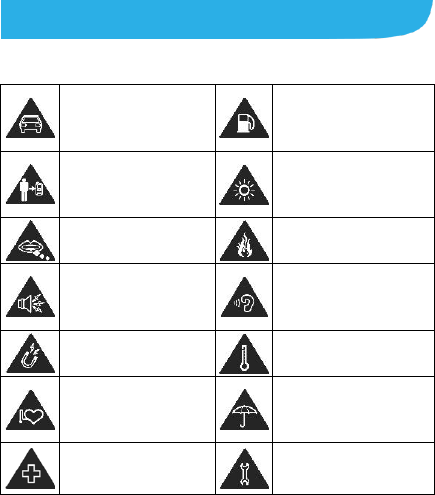
112
For Your Safety
General Safety
Don’t make or receive
handheld calls while
driving. Never text while
driving.
Don’t use at gas stations.
Keep your phone at least
15 mm away from your
ear or body while making
calls.
Your phone may produce a
bright or flashing light.
Small parts may cause
choking.
Don’t dispose of your
phone in fire.
Your phone can produce
a loud sound.
To prevent possible
hearing damage, do not
listen at high volume levels
for long periods.
Avoid contact with
anything magnetic.
Avoid extreme
temperatures.
Keep away from
pacemakers and other
electronic medical
devices.
Avoid contact with liquids.
Keep your phone dry.
Turn off when asked to in
hospitals and medical
facilities.
Don’t take your phone
apart.

113
Turn off when told to in
aircrafts and airports.
Only use approved
accessories.
Turn off when near
explosive materials or
liquids.
Don’t rely on your phone
for emergency
communications.
FCC RF Exposure Information (SAR)
This phone is designed and manufactured not to exceed the
emission limits for exposure to radio frequency (RF) energy set
by the Federal Communications Commission of the United
States.
During SAR testing, this device was set to transmit at its highest
certified power level in all tested frequency bands, and placed
in positions that simulate RF exposure in usage against the
head with no separation, and near the body with the separation
of 10 mm. Although the SAR is determined at the highest
certified power level, the actual SAR level of the device while
operating can be well below the maximum value. This is
because the phone is designed to operate at multiple power
levels so as to use only the power required to reach the network.
In general, the closer you are to a wireless base station
antenna, the lower the power output.
The exposure standard for wireless devices employs a unit of
measurement known as the Specific Absorption Rate, or
SAR. The SAR limit set by the FCC is 1.6 W/kg.
Tests for SAR are conducted using standard operating positions

114
accepted by the FCC with the device transmitting at its highest
certified power level in all tested frequency bands.
The FCC has granted an Equipment Authorization for this
model phone with all reported SAR levels evaluated as in
compliance with the FCC RF exposure guidelines. SAR
information on this model phone is on file with the FCC and can
be found under the Display Grant section of
www.fcc.gov/oet/ea/fccid after searching on FCC ID:
SRQ-Z828.
For this device, the highest reported SAR value for usage
against the head is 1.04 W/kg, for usage near the body is 1.19
W/kg.
While there may be differences between the SAR levels of
various phones and at various positions, they all meet the
government requirements.
SAR compliance for body-worn operation is based on a
separation distance of 10 mm between the unit and the human
body. Carry this device at least 10 mm away from your body to
ensure RF exposure level compliant or lower to the reported
level. To support body-worn operation, choose the belt clips or
holsters, which do not contain metallic components, to maintain
a separation of 10 mm between this device and your body.
RF exposure compliance with any body-worn accessory, which
contains metal, was not tested and certified, and use such
body-worn accessory should be avoided.
115
FCC Regulations
This mobile phone complies with part 15 of the FCC Rules.
Operation is subject to the following two conditions: (1) This
device may not cause harmful interference, and (2) this device
must accept any interference received, including interference
that may cause undesired operation.
This mobile phone has been tested and found to comply with
the limits for a Class B digital device, pursuant to Part 15 of the
FCC Rules. These limits are designed to provide reasonable
protection against harmful interference in a residential
installation. This equipment generates, uses and can radiate
radio frequency energy and, if not installed and used in
accordance with the instructions, may cause harmful
interference to radio communications. However, there is no
guarantee that interference will not occur in a particular
installation. If this equipment does cause harmful interference
to radio or television reception, which can be determined by
turning the equipment off and on, the user is encouraged to try
to correct the interference by one or more of the following
measures:
Reorient or relocate the receiving antenna.
Increase the separation between the equipment and receiver.
Connect the equipment into an outlet on a circuit different
from that to which the receiver is connected.
Consult the dealer or an experienced radio/TV technician for
help.

116
CAUTION:
Changes or modifications not expressly approved by the party
responsible for compliance could void the user’s authority to
operate the equipment.
The antenna(s) used for this transmitter must not be co-located
or operating in conjunction with any other antenna or
transmitter.
Hearing Aid Compatibility (HAC)
regulations for Mobile Phones
In 2003, the FCC adopted rules to make digital wireless
telephones compatible with hearing aids and cochlear implants.
Although analog wireless phones do not usually cause
interference with hearing aids or cochlear implants, digital
wireless phones sometimes do because of electromagnetic
energy emitted by the phone's antenna, backlight, or other
components. Your phone is compliant with FCC HAC regulations
(ANSI C63.19- 2011). While some wireless phones are used
near some hearing devices (hearing aids and cochlear implants),
users may detect a buzzing, humming, or whining noise. Some
hearing devices are more immune than others to this interference
noise and phones also vary in the amount of interference they
generate. The wireless telephone industry has developed a
rating system for wireless phones to assist hearing device users
in finding phones that may be compatible with their hearing
devices. Not all phones have been rated. Phones that are rated
117
have the rating on their box or a label located on the box. The
ratings are not guarantees. Results will vary depending on the
user's hearing device and hearing loss. If your hearing device
happens to be vulnerable to interference, you may not be able to
use a rated phone successfully. Trying out the phone with your
hearing device is the best way to evaluate it for your personal
needs.
This phone has been tested and rated for use with hearing aids
for some of the wireless technologies that it uses. However, there
may be some newer wireless technologies used in this phone
that have not been tested yet for use with hearing aids. It is
important to try the different features of this phone thoroughly
and in different locations, using your hearing aid or cochlear
implant, to determine if you hear any interfering noise. Consult
your service provider or the manufacturer of this phone for
information on hearing aid compatibility. If you have questions
about return or exchange policies, consult your service provider
or phone retailer.
M-Ratings: Phones rated M3 or M4 meet FCC requirements and
are likely to generate less interference to hearing devices than
phones that are not labeled. M4 is the better/higher of the two
ratings.
T-Ratings: Phones rated T3 or T4 meet FCC requirements and
are likely to be more usable with a hearing device’s telecoil (“T
Switch” or “Telephone Switch”) than unrated phones. T4 is the
better/ higher of the two ratings. (Note that not all hearing devices
have telecoils in them.)
Your phone meets the M3/T3 level rating.
118
Hearing devices may also be rated. Your hearing device
manufacturer or hearing health professional may help you find
this rating. For more information about FCC Hearing Aid
Compatibility, please go to http://www.fcc.gov/cgb/dro.
CTIA Requirements
Do not disassemble or open crush, bend or deform, puncture
or shred.
Do not modify or remanufacture, attempt to insert foreign
objects into the battery, immerse or expose to water or other
liquids, expose to fire, explosion or other hazard.
Only use the battery for the system for which it is specified.
Only use the battery with a charging system that has been
qualified with the system per CTIA Certification Requirements
for Battery System Compliance to IEEE 1725. Use of an
unqualified battery or charger may present a risk of fire,
explosion, leakage, or other hazard.
Do not short circuit a battery or allow metallic conductive
objects to contact battery terminals.
Replace the battery only with another battery that has been
qualified with the system per this standard, IEEE-Std-1725.
Use of an unqualified battery may present a risk of fire,
explosion, leakage or other hazard.
Promptly dispose of used batteries in accordance with local
regulations.
119
Battery usage by children should be supervised.
Avoid dropping the phone or battery. If the phone or battery is
dropped, especially on a hard surface, and the user suspects
damage, take it to a service center for inspection.
Improper battery use may result in a fire, explosion or other
hazard.
The phone shall only be connected to CTIA certified adapters,
products that bear the USB-IF logo or products that have
completed the USB-IF compliance program.
Radio Frequency Interference
General Statement on Interference
Care must be taken when using the phone in close proximity to
personal medical devices, such as pacemakers and hearing aids.
Pacemakers
Pacemaker manufacturers recommend that a minimum
separation of 15 cm be maintained between a mobile phone and
a pacemaker to avoid potential interference with the pacemaker.
To achieve this, use the phone on the opposite ear to your
pacemaker and do not carry it in a breast pocket.
Hearing Aids
People with hearing aids or other cochlear implants may
120
experience interfering noises when using wireless devices or
when one is nearby.
The level of interference will depend on the type of hearing
device and the distance from the interference source. Increasing
the separation between them may reduce the interference. You
may also consult your hearing aid manufacturer to discuss
alternatives.
Medical Devices
Please consult your doctor and the device manufacturer to
determine if operation of your phone may interfere with the
operation of your medical device.
Hospitals
Turn off your wireless device when requested to do so in
hospitals, clinics or health care facilities. These requests are
designed to prevent possible interference with sensitive medical
equipment.
Aircraft
Turn off your wireless device whenever you are instructed to do
so by airport or airline staff.
Consult the airline staff about the use of wireless devices
onboard the aircraft. If your device offers a ‘flight mode’, this must
be enabled prior to boarding an aircraft.
121
Interference in Cars
Please note that because of possible interference with electronic
equipment, some vehicle manufacturers forbid the use of mobile
phones in their vehicles unless a hands-free kit with an external
antenna is included in the installation.
Explosive Environments
Gas Stations and Explosive Atmospheres
In locations with potentially explosive atmospheres, obey all
posted signs to turn off wireless devices such as your phone or
other radio equipment.
Areas with potentially explosive atmospheres include fueling
areas, below decks on boats, fuel or chemical transfer or storage
facilities, and areas where the air contains chemicals or particles,
such as grain, dust, or metal powders.
Blasting Caps and Areas
Power off your mobile phone or wireless device when in a
blasting area or in areas posted power off “two-way radios” or
“electronic devices” to avoid interfering with blasting operations.